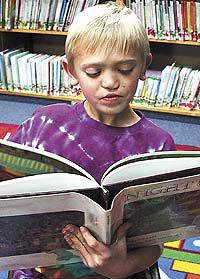| Zachary Hume, 10, reports that he loves to read and enjoys spending his time at the Price Library. |
Despite a recent government report claiming that Americans aren’t reading books much anymore, Norma Procarione, the head librarian at the Price City Library said she doesn’t see that trend in Carbon County.
“We lend out around 200 to 250 books a day,” she said. “We are seeing a lot more children reading. Some of them checking out as many 15 books at one time.”
Procarione said the most popular books are the easy readers for kids, followed by adult fiction. She said adults tend to read the usual genres, such as mystery and horror – especially vampire stories – and whatever’s on the bestsellers lists.
“Even if John Grisham isn’t writing about law, people will read the book, because it’s John Grisham,” she said.
The 99-page study, “To Read or Not to Read,” was Monday as a follow-up to a 2004 NEA survey, “Reading at Risk,” that found an increasing number of adult Americans were not even reading one book a year.
“To Read or Not to Read” gathers an array of government, academic and foundation data on everything from how many 9-year-olds read every day for “fun” (54 percent) to the percentage of high school graduates deemed by employers as “deficient” in writing in English (72 percent).
“I’ve done a lot of work in statistics in my career, and I’ve never seen a situation where so much data was pulled from so many places and absolutely everything is so consistent,” NEA chairman Dana Gioia said.
Among the findings:
• In 2002, only 52 percent of Americans ages 18 to 24, the college years, read a book voluntarily, down from 59 percent in 1992.
• Money spent on books, adjusted for inflation, dropped 14 percent from 1985 to 2005 and has fallen dramatically since the mid-1990s.
• The number of adults with bachelor’s degrees and “proficient in reading prose” dropped from 40 percent in 1992 to 31 percent in 2003.
Some news is good, notably among 9-year-olds, whose reading comprehension scores have soared since the early 1990s.
| Joshua Vouk and Johathan Vasquez select of Price make their selection. |
But at the same time, the number of 17-year-olds who “never or hardly ever” read for pleasure has doubled, to 19 percent, and their comprehension scores have fallen.
“I think there’s been an enormous investment in teaching kids to read in elementary school,” Gioia said. “Kids are doing better at 9, and at 11. At 13, they’re doing no worse, but then you see this catastrophic falloff. … If kids are put into this electronic culture without any counterbalancing efforts, they will stop reading.”
Publishers and booksellers have noted that teen fiction is a rapidly expanding category in an otherwise flat market, but the NEA’s director of research, Sunil Iyengar, wondered how much of that growth has been caused by the “Harry Potter” books, the last of which came out in July.
“It’s great that millions of kids are reading these long, intricate novels, but reading one such book every 18 months doesn’t make up for daily reading,” Gioia said.
Doug Whiteman, president of the Penguin Young Readers Group, a division of Penguin Group (USA), said sales of teen books were the strongest part of his business. But he added that a couple of factors could explain why scores were dropping: Adults are also buying the
“Potter” books, thus making the teen market seem bigger on paper, and some sales are for non-English language books.
“There are so many nuances,” Whiteman said. “Reading scores don’t necessarily have any relevance to today’s sales.”
The head of Simon & Schuster’s children’s publishing division, Rick Richter, saw another reason why sales could rise even as scores go down: A growing gap between those who read and those who don’t. Richter considers it “very possible” that the market is driven by a relatively small number of young people who buy large numbers of books. Test scores, meanwhile, are lowered by the larger population of teens who don’t read.
“A divide like that is really a cause for concern,” Richter said.
The report emphasizes the social benefits of reading: “Literary readers” are more likely to exercise, visit art museums, keep up with current events, vote in presidential elections and perform volunteer work.
“This should explode the notion that reading is somehow a passive activity,” Gioia said. “Reading creates people who are more active by any measure. … People who don’t read, who spend more of their time watching TV or on the Internet, playing video games, seem to be significantly more passive.”
Gioia called the decline in reading “perhaps the most important socio-economic issue in the United States,” and called for changes “in the way we’re educating kids, especially in high school and college. We need to reconnect reading with pleasure and enlightenment.”
“To Read or Not to Read’ suggests we are losing the majority of the new generation,” Gioia said. “The majority of young Americans will not realize their individual, economic or social potential.”

